Standard [CURRENT]
ASTM D 5126:2025
Standard Guide for Comparison of Field Methods for Determining Hydraulic Conductivity in Vadose Zone
- German title
- Leitlinie für den Vergleich von Methoden zur Bestimmung der Durchlässigkeitsziffer in der vadosen Zone unter Einsatzbedingungen
- Publication date
- 2025
- Original language
- English
- Pages
- 12
- Publication date
- 2025
- Original language
- English
- Pages
- 12
- DOI
- https://dx.doi.org/10.1520/D5126-25
Product information on this site:
Quick delivery via download or delivery service
Buy securely with a credit card or pay upon receipt of invoice
All transactions are encrypted
Short description
1.1 This guide covers a review of the test methods for determining hydraulic conductivity in unsaturated soils and sediments. Test methods for determining both field-saturated and unsaturated hydraulic conductivity are described. 1.2 Measurement of hydraulic conductivity in the field is used for estimating the rate of water movement through clay liners to determine if they are a barrier to water flux, for characterizing water movement below waste disposal sites to predict contaminant movement, and to measure infiltration and drainage in soils and sediment for a variety of applications. Test methods are needed for measuring hydraulic conductivity ranging from 1 × 10−4 to 1 × 10−10 m/s, for both surface and subsurface layers, and for both field-saturated and unsaturated flow. 1.3 For these field test methods a distinction is made between "saturated" ( K s ) and "field-saturated" ( K fs ) hydraulic conductivity. True saturated conditions seldom occur in the vadose zone except where impermeable layers result in the presence of perched water tables. During infiltration events or in the event of a leak from a lined pond, a "field-saturated" condition develops. True saturation does not occur due to entrapped air ( 1 ) . 2 The entrapped air prevents water from moving in air-filled pores that, in turn, may reduce the hydraulic conductivity measured in the field by as much as a factor of two compared to conditions when trapped air is not present ( 2 ) . Field test methods should simulate the "field-saturated" condition. 1.4 Field test methods commonly used to determine field-saturated hydraulic conductivity include various double-ring infiltrometer test methods, air-entry permeameter test methods, and borehole permeameter tests. Many empirical test methods are used for calculating hydraulic conductivity from data obtained with each test method. A general description of each test method and special characteristics affecting applicability is provided. 1.5 Field test methods used to determine unsaturated hydraulic conductivity in the field include direct measurement techniques and various estimation methods. Direct measurement techniques for determining unsaturated hydraulic conductivity include the instantaneous profile (IP) test method and the gypsum crust method. Estimation techniques have been developed using borehole permeameter data and using data obtained from desorption curves (a curve relating water content to matric potential). 1.6 The values stated in SI units are to be regarded as standard. No other units of measurement are included in this standard. Hydraulic conductivity is described in m/s in this standard guide. It has been common industry practice to report hydraulic conductivity in cm/s. Practice D8152 describes hydraulic conductivity in mm/h. These units (cm/s and mm/h) are in compliance with this standard guide. 1.7 All observed and calculated values shall conform to the guidelines for significant digits and rounding established in Practice D6026 . 1.7.1 The method used to specify how data are collected, calculated, or recorded in this standard is not directly related to the accuracy to which the data can be applied in design or other uses, or both. How one applies the results obtained using this standard is beyond its scope. 1.8 This standard does not purport to address all of the safety concerns, if any, associated with its use. It is the responsibility of the user of this standard to establish appropriate safety, health, and environmental practices and determine the applicability of regulatory limitations prior to use. 1.9 This guide offers an organized collection of information or a series of options and does not recommend a specific course of action. This document cannot replace education or experience and should be used in conjunction with professional judgment. Not all aspects of this guide may be applicable in all circumstances. This ASTM standard is not intended to represent or replace the standard of care by which the adequacy of a given professional service must be judged, nor should this document be applied without consideration of a project's many unique aspects. The word "Standard" in the title of this document means only that the document has been approved through the ASTM consensus process. 1.10 This international standard was developed in accordance with internationally recognized principles on standardization established in the Decision on Principles for the Development of International Standards, Guides and Recommendations issued by the World Trade Organization Technical Barriers to Trade (TBT) Committee.
ICS
07.060
DOI
https://dx.doi.org/10.1520/D5126-25
Also available in
Loading recommended items...
Loading recommended items...
Loading recommended items...
Loading recommended items...

